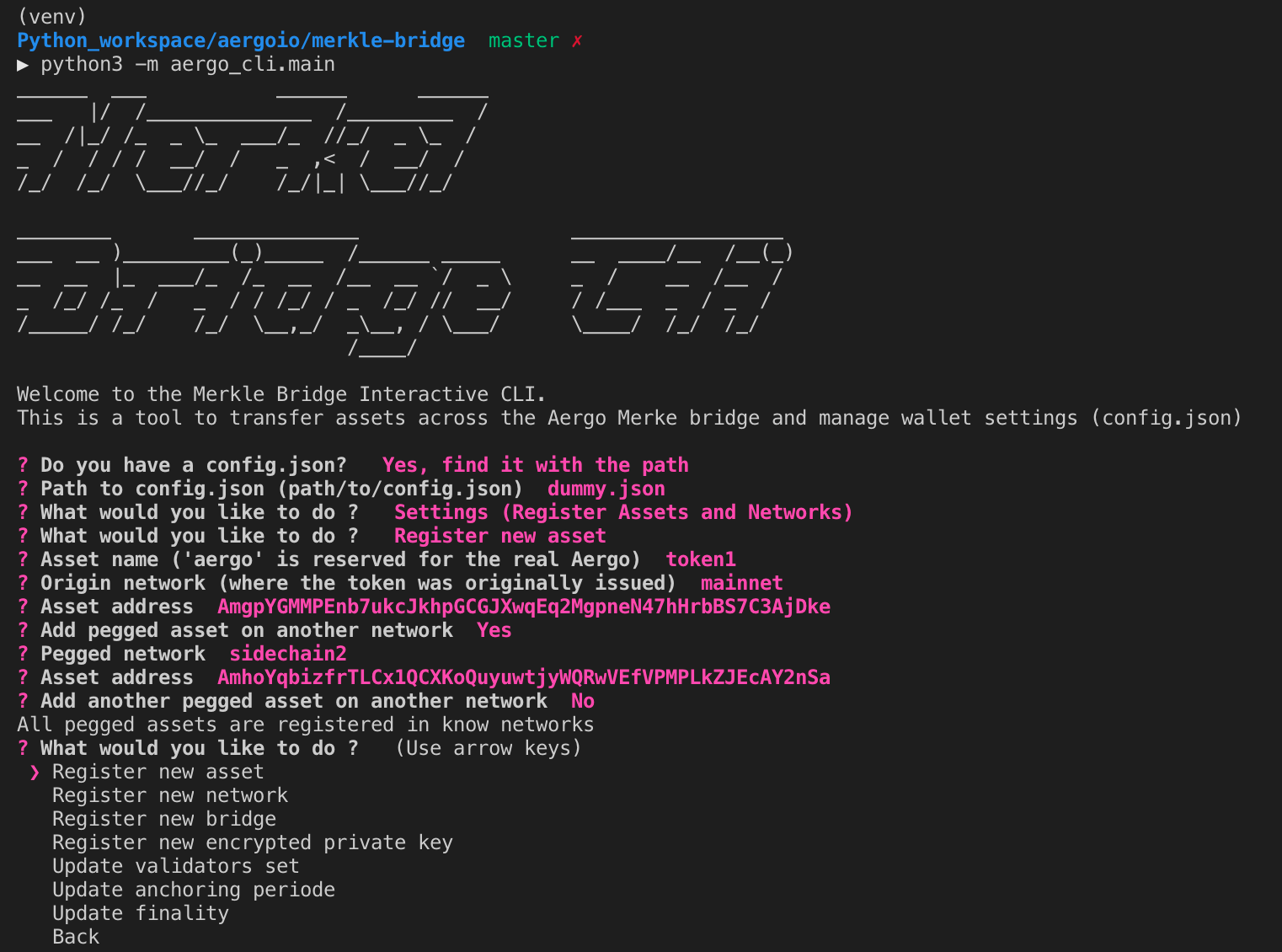Python wallet¶
The Python wallet can be used as a python command line tool for making simple transfers, bridge transfers, quering balances … The merkle-bridge/aergo_wallet repository can also be used as a module for other applications as the tools are separate and don’t need config.json to be used.
Create / Register a new account¶
from aergo_wallet.wallet import AergoWallet
# create a wallet
wallet = AergoWallet("./config.json")
# create a new account (new private key),
# you will be requested to create a password
# (DO NOT LOSE IT, it is the only way to decrypt your private key)
wallet.create_account("default")
# if you already have an exported private key (created by aergocli for example)
wallet.register_account('default', "exported_private_key", addr="Address_of_private_key")
Balance query¶
from aergo_wallet.wallet import AergoWallet
# create a wallet
wallet = AergoWallet("./config.json")
# get Aer balance of the default account on 'mainnet'
balance, _ = wallet.get_balance('aergo', 'mainnet')
# get Aer balance of Aer minted on 'sidechain2'
balance, _ = wallet.get_balance('aergo', 'sidechain2',
asset_origin_chain='mainnet')
Deploy a test token¶
from aergo_wallet.wallet import AergoWallet
# load the compiled bytecode
with open("./contracts/token_bytecode.txt", "r") as f:
bytecode = f.read()[:-1]
# create a wallet
wallet = AergoWallet("./config.json")
total_supply = 500*10**18
token_name = "my_token"
# deploy the token and store the address in config.json
wallet.deploy_token(bytecode, token_name, total_supply, "mainnet")
Register an already deployed token¶
This can be done with aergo_cli

or by editing config.json directly.
{
"tokens": {
"my_token": {
"addr": "AmgY8WARSNfjgCnFhFJBv145wkHJRTC7YR5MeJGAMvKzVD9kKeFz",
"pegs": {
"sidechain2": "AmheFWQf5decPrKZE1dnjh1EFwDq7qqAmobPbrUt4XeNK9QNCyxK"
}
}
}
}
or with the wallet:
from aergo_wallet.wallet import AergoWallet
# create a wallet
wallet = AergoWallet("./config.json")
" Register a 'mainnet' token and it's pegged self on 'sidechain2'
wallet.register_asset("my_token", "mainnet", "Address on mainnet",
pegged_chain_name="sidechain2",
addr_on_pegged_chain="Address on sidechain2")
Simple Transfers¶
from aergo_wallet.wallet import AergoWallet
# create a wallet
wallet = AergoWallet("./config.json")
# simple asset transfer on 'mainnet'
wallet.transfer(2*10**18, to_address, asset_name="my_token", network_name="mainnet")
# simple asset transfer of 'mainnet' assets pegged on 'sidechain'
wallet.transfer(2*10**18, to_address, asset_name="my_token", network_name="sidechain",
asset_origin_chain="mainnet")
Bridge Transfers¶
The bridge_transfer method calls transfer_to_sidechain or transfer_from_sidechain depending whether the token was minted or not.
from aergo_wallet.wallet import AergoWallet
# create a wallet
wallet = AergoWallet("./config.json")
amount = 1*10**18
asset = 'token1'
# transfer aergo from 'mainnet' to 'sidechain2'
wallet.bridge_transfer('mainnet',
'sidechain2',
asset,
amount)
The transfer_to_sidechain method performs the following:
- lock assets in the bridge contract
- wait for the next anchor on sidechain
- create a merkle proof of lock in the anchored state
- mint the asset on the sidechain with the merkle proof
The transfer_from_sidechain method performs the following:
- brun assets in the bridge contract
- wait for the next anchor on mainnet
- create a merkle proof of burn in the anchored state
- unlock the asset on the mainnet with the merkle proof
from aergo_wallet.wallet import AergoWallet
# create a wallet
wallet = AergoWallet("./config.json")
amount = 1*10**18
asset = 'token1'
# transfer aergo from 'mainnet' to 'sidechain2'
wallet.transfer_to_sidechain('mainnet',
'sidechain2',
asset,
amount)
# transfer minted aergo from sidechain2 mainnet
wallet.transfer_from_sidechain('sidechain2',
'mainnet',
asset,
amount)
It is also possible to perform the lock/burn and mint/unlock operations individually.
from aergo_wallet.wallet import AergoWallet
# create a wallet
wallet = AergoWallet("./config.json")
amount = 1*10**18
asset = 'token1'
# lock asset in the bridge contract to 'sidechain2'
lock_height, tx_hash = wallet.initiate_transfer_lock('mainnet', 'sidechain2',
asset, amount)
# lock more assets in the bridge contract to 'sidechain2'
lock_height, tx_hash = wallet.initiate_transfer_lock('mainnet', 'sidechain2',
asset, amount)
# get the amount of assets locked but not yet minted on 'sidechain2'
pending_mint = wallet.get_minteable_balance(
'mainnet', 'sidechain2', asset, pending=True
)
# mint the total balance of two previous locked amounts
pegged_address, tx_hash = wallet.finalize_transfer_mint(
'mainnet', 'sidechain2', asset, lock_height=lock_height
)
# Similarly,
# wallet.initiate_transfer_burn()
# wallet.get_unlockeable_balance()
# wallet.finalize_transfer_unlock()
# can be used to burn and unlock minted assets from a sidechain.
Wallet utils¶
If you wish to use the wallet as a module for other applications, the following tools are available:
- wallet_utils.py
- transfer_to_sidechain.py
- transfer_from_sidechain.py
- token_deployer.py
You will need to connect your own herapy instances to nodes and load your private key in herapy.